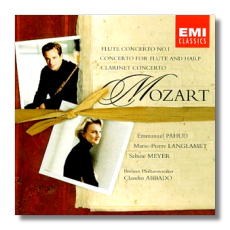
The Internet's Premier Classical Music Source
Related Links
- Mozart Reviews
- Latest Reviews
- More Reviews
-
By Composer
-
Collections
DVD & Blu-ray
Books
Concert Reviews
Articles/Interviews
Software
Audio
Search Amazon
Recommended Links
Site News
 CD Review
CD Review
Wolfgang Mozart

Concertos for Winds
- Flute Concerto #1 in G Major, K. 313
- Concerto for Flute and Harp in C Major, K. 299
- Clarinet Concerto in A Major, K. 622
Emmanuel Pahud, flute
Marie-Pierre Langlamet, harp
Sabine Meyer, basset-clarinet
Berlin Philharmonic Orchestra/Claudio Abbado
EMI Classics CDC5571282 DDD 78:54
The main motivation behind this new release must be Emmanuel Pahud, the young superstar flutist signed as an exclusive artist to EMI Classics in 1996. A recent Bach disc (EMI CDC57111) created immediate enjoyment. This new Mozart CD is hardly less pleasurable, although the orchestral contribution is "fatter" here than it was on the Bach CD.
Of course, the flute concertos (with and without harp) are like musical sighs of relief and contentment, even though the composer, at least initially, is said to have disliked the flute. Pahud plays these two works with the purest tone and with Apollonian poise. The outer movements display his agility, but he never seems to be merely "showing off." The slow movements, perhaps a trifle cool, are nevertheless very stylish and involving. Grasping for spurious effects seems to be the farthest thing from Pahud's mind. In the C-major concerto, Marie-Pierre Langlamet is a good partner. In this concerto, however, it seems inevitable that the harp's contribution is less prominent than the flute's, and Langlamet doesn't make an impression the way that Pahud does. The soloists play their own cadenzas; the cadenza in the double concerto is based on Robert D. Levin and Marius Flothuis. (Mozart's original cadenzas have been lost.)
Sabine Meyer, no stranger to K. 622, plays the concerto on the largely extinct basset-clarinet on this recording. The main difference between the basset-clarinet and the plain old clarinet is that former has an extended lower range; when K. 622 is played on the clarinet (as it almost always is), some of the phrases are rewritten to accommodate the clarinet's "short" lower range. The differences are hardly that important. Some claim the basset-clarinet's tone is mellower, but that is a matter of opinion. What is important is that Meyer is a wonderful musician, whatever she plays, and this new recording is a font of bright and cheerful basset-clarinet tone. Meyer carefully pays attention to dynamic and legato/staccato contrasts, so her playing is endlessly interesting, as well as tonally gratifying. Other recordings of this work make more of the dark clouds that lurk beneath the surface, but I've come to think that it's psychologically facile to look for incipient tragedy in every late work of Mozart's.
Abbado, an accommodating conductor, doesn't overwhelm them, but he and the Berlin Philharmonic seem to be in favor of a more Romantic Mozart than Pahud and Meyer are. The contrast between the "warm" Berlin musicians and the cooler soloists isn't unpleasant; it's just noticeable.
All three works were recorded in the Berlin Philharmonie; K. 622 was recorded under live conditions, but the audience is silent. The engineering on this CD is extremely fine, and Julian Haylock's annotations are informative. If this combination of concertos appeals to you, then you don't need to hesitate.
Copyright © 2001, Raymond Tuttle


















